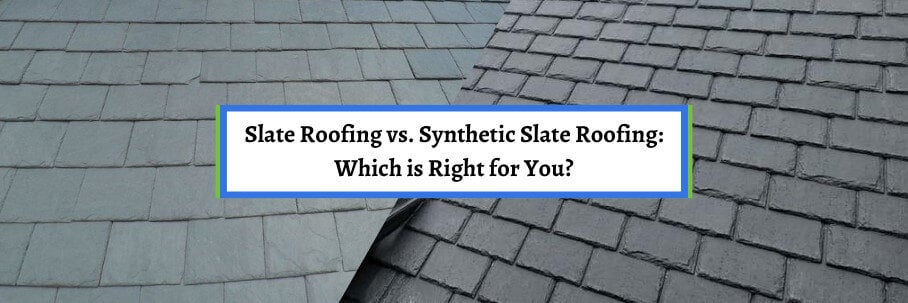Slate Roof | Synthetic roof shingles
Slate Roofing vs. Synthetic Slate Roofing: Which is Right for You?

Are you interested in slate roofing? Did you know there are actually natural and synthetic options?
Slate has been used in roofing for centuries. But as technology improved, the roofing industry has developed synthetic shingles.
They look exactly like natural slate and continue to grow more popular by the day. But while the synthetic shingles look almost the same as the real thing, they have major differences.
So, let’s match up an older, established material vs. a new, modern material.
For over 30 years, Bill Ragan Roofing has taken pride in giving homeowners the confidence they need to choose the right roofing material. That’s why I’ll break down the key differences between natural and synthetic slate roofing.
We’ll start with a quick overview of natural slate and synthetic slate, including their pros and cons. After that, I compare the two roofing materials on the factors you need to consider when making a decision.
What is a natural slate roof?
A slate roof is a premium roof system made primarily out of natural slate tiles and other slate roofing materials. The slate is mined (mostly in Italy) and cut into square tiles.

Unlike other roofing materials that come in 3-foot wide strips or metal panels, slate tiles are installed one at a time.
Slate roofing pros:
- Longest-lasting roofing material available
- Very high curb appeal
- Durable
Slate roofing cons:
- Expensive
- The weight factor
- Slate tiles are fragile
- Slow and skillful installation
- Harder to repair
- No material warranty
What is a synthetic slate roof?
Synthetic (also called composite) slate shingles are made of a synthetic polymer or recycled materials and designed to look exactly like natural slate tiles. This roofing material is a newcomer to the roofing industry, but it’s becoming increasingly popular among homeowners.
.jpg?width=600&height=338&name=Synthetic%20(1).jpg)
Synthetic shingle roofing pros:
- Eco-friendly
- Very high curb appeal
- Class 4 impact rating
- No cracking or breaking like natural material counterparts
- Cheaper than the materials it mimics
Synthetic shingle roofing cons:
- Newer to the roofing industry
- Expensive
Natural slate roofing vs. synthetic slate roofing
Now, you know the pros and cons of natural and synthetic slate roofing. While this gives you an idea of their differences, you still need to dig deeper into the things that determine which one is right for you.
Let’s compare natural slate roofing to synthetic slate roofing on:
- Availability in the United States
- The weight of materials
- Installation
- Lifespan
- Material warranties
- Pricing
Availability in the United States
Both roofing materials are used in the United States, but the availability for both varies. It honestly depends on what suppliers in your area have in stock, but natural slate usually takes longer to get.
As I said in the beginning, slate tiles are usually mined overseas. So, there’s no telling how long it can take to ship to the United States.
On the other hand, most synthetic shingle manufacturers are state-side. This makes getting the shingles easier, especially if a supplier continuously restocks them.
However, the manufacturing schedule can greatly impact how soon synthetic shingles are available. So, there’s a chance you’ll have to wait for the materials to be delivered, no matter if they’re natural or synthetic.
The weight of materials
For most materials, you don’t have to worry about their weight. However, a natural slate roof is incredibly heavy compared to a synthetic slate roof and other roofing materials.
Your home actually has to be built or framed to hold the weight of a natural slate roof to avoid the walls and roof from caving in. You’ll actually have to retrofit your home if it can’t withstand the weight of natural slate the way it is.
On the other hand, synthetic slate shingles are lightweight. So, you won’t have to worry about the weight and pay the price of retrofitting your home like a natural slate roof.
Installation
Both natural slate and synthetic slate installation is a slow, labor-intensive, and time-consuming project. This is simply because every tile and shingle is installed individually.
Even so, installing natural slate is much more difficult. Each tile must be handled carefully before, during, and after installation because they break so easily.

The tiles are also much heavier and harder to handle than synthetic shingles. But no matter what, installing natural slate and synthetic slate is a completely different skill set than normal shingles.
So, it’s crucial to hire a local roofer with experience working with and installing the specific material.
Lifespan
A properly installed and flashed slate roof is widely considered to be one of the longest-lasting residential roofing materials. There’s no reason a slate roof shouldn’t live 75 or even close to 100 years.
On the other hand, a properly installed synthetic slate shingle roof should last around 40-50 years. While this is still a great lifespan, a natural slate roof has the upper hand in this category.
However, installation quality and other factors ultimately determine how long both roof systems last.
Material warranties
You get two warranties when getting a new roof: workmanship and material. While the workmanship warranty depends on the roofer you hire, the material warranty for natural slate and synthetic slate is very different.
Natural slate tiles usually have no material warranty because they aren’t necessarily manufactured. So, you’ll have to rely on a contractor’s workmanship warranty if there’s ever a problem.
However, most synthetic slate shingles come with some kind of lifetime limited material warranty, depending on the manufacturer. That’s why it’s important to talk to your roofing contractor about the synthetic shingle manufacturer they use and their warranties.
Pricing
Natural slate and synthetic slate are considered premium roof systems. They both require large budgets, but a synthetic slate roof will be cheaper than a natural slate roof.
Synthetic slate is usually around half the price for the shingles and components compared to natural slate. While it’s impossible to be exact due to all the pricing factors, I can give you an idea of the budget needed for both.
A natural slate roof will start at around $15.00 to $20.00 per square foot and potentially up to around $30.00 or more per square foot. On the other hand, a synthetic slate roof will cost around $14.00 to $20.00 per square foot but can get higher based on your area and roofer.
What other residential roofing materials should you consider?
After reading this article, you should have a good idea if natural slate or synthetic slate is right for you. Both are great roof systems, but synthetic slate is a more realistic option.
This is not only due to pricing but also because it comes with material warranties and the weight of natural slate. And if your home can’t handle the weight, you’re looking at a larger and much more costly project.
However, there’s also a good chance that neither one is right for you. If that’s the case, there are plenty of other materials for you to consider.
So, whether slate (natural or synthetic) isn’t the right fit or you just want to know your options, I wrote another article breaking down the top residential roofing materials.
Check out The Top 8 Types of Roofing Materials (& How to Choose the Right One) to get the information you need to make the best decision based on your budget, home’s look, and more.


